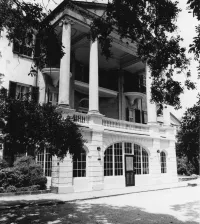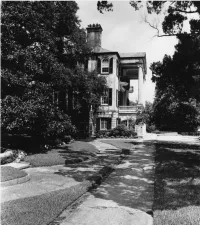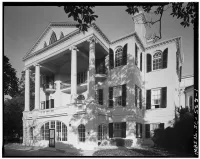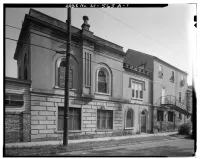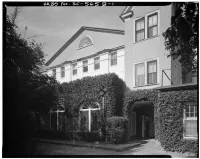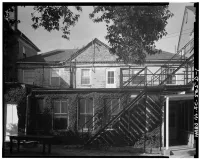Share what you know,
and discover more.
Share what you know,
and discover more.
Aug 30, 1974
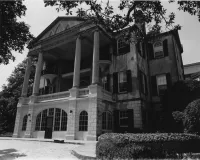
-

- Charmaine Bantugan
National Register of Historic Places - James Nicholson House
Statement of Significant: Constructed ca. 1816, Ashley Hall was once the home of wealthy Charleston merchants. Distinctive architecturally, it now serves as a private school for girls. Architecture: Although Ashley Hall has been attributed to William Jay, the exuberance of the structure is foreign to the classic restraint of that architect. The structure's attribution to Jay was based upon the high elevation of the main floor above the ground and the height of the principal rooms; in addition, the unusual expression of triptych Gothic windows in the otherwise classic revival pediment are indicative of Jay's designs. The portico is oarrieii by four giant-order unfluted Ionic columns with Scamozzi capitals placed in a Palladian stance. Behind the portico is a deeply convex apse with second-story balconies with wrought-iron railings. The interior curved walls echo the apsidal niche of the portico and the extruded semicircular balconies to either side of the building. The entire house rests upon a high basement with arcade, the arches of which-echo the stance of the columns of the portico. In the architectural survey of Charleston, a jury composed of Dr. William Murtagh, Keeper of the National Register of Historic Places, Professor Bernard Lemann, Tulane University School of Architecture, Mr. Carl Feiss and Mr. Russell Wright, consultants to the city, noted this structure as exceptional. The notation indicates that the building is of the highest architectural design quality, well-proportioned, and architecturally sophisticated. Windows, classical orders or other period designs, chimneys, verandas, massing, materials, textures, refined detail, and craftsmanship is all elegant and innovative. The structure is to be preserved and protected in situ at all costs. Commerce and Politics: In 1838 James R. Pringle bought the house. Pringle was a prominent Unionist during the Nullification controversy and a member of the state legislature from 1808 to 1818. At the time he bought the house, Pringle was the collector of customs for the port of Charleston. Pringle sold the house to George A. Trenholm in 1845. Trenholm was a wealthy merchant and financier who became Secretary of the Confederate Treasury in 1864. He was president of the John Fraser trading house, which had a branch in Liverpool. This company, known as Fraser, Trenholm, and Company acted on behalf of the Confederate States of America in purchasing European goods. Trenholm also controlled a fleet of blockade Education: In 1909 Mary Vardrine McBee founded Ashley Hall, a preparatory school for girls. Charleston Deeds lists Patrick Duncan as acquiring ownership of this property in 1798. In 1802 the Charleston City Directory gave the address of Duncan as being "over Cannon's Bridge" which includes the area that is today, Rutledge Avenue. Although land ownership is dated as early as the turn of the century, architecturally the house appears to have been constructed ca. 1816. The historic name of this structure refers to James Nicholson, who owned the house from 1829 to 1838.
National Register of Historic Places - James Nicholson House
Statement of Significant: Constructed ca. 1816, Ashley Hall was once the home of wealthy Charleston merchants. Distinctive architecturally, it now serves as a private school for girls. Architecture: Although Ashley Hall has been attributed to William Jay, the exuberance of the structure is foreign to the classic restraint of that architect. The structure's attribution to Jay was based upon the high elevation of the main floor above the ground and the height of the principal rooms; in addition, the unusual expression of triptych Gothic windows in the otherwise classic revival pediment are indicative of Jay's designs. The portico is oarrieii by four giant-order unfluted Ionic columns with Scamozzi capitals placed in a Palladian stance. Behind the portico is a deeply convex apse with second-story balconies with wrought-iron railings. The interior curved walls echo the apsidal niche of the portico and the extruded semicircular balconies to either side of the building. The entire house rests upon a high basement with arcade, the arches of which-echo the stance of the columns of the portico. In the architectural survey of Charleston, a jury composed of Dr. William Murtagh, Keeper of the National Register of Historic Places, Professor Bernard Lemann, Tulane University School of Architecture, Mr. Carl Feiss and Mr. Russell Wright, consultants to the city, noted this structure as exceptional. The notation indicates that the building is of the highest architectural design quality, well-proportioned, and architecturally sophisticated. Windows, classical orders or other period designs, chimneys, verandas, massing, materials, textures, refined detail, and craftsmanship is all elegant and innovative. The structure is to be preserved and protected in situ at all costs. Commerce and Politics: In 1838 James R. Pringle bought the house. Pringle was a prominent Unionist during the Nullification controversy and a member of the state legislature from 1808 to 1818. At the time he bought the house, Pringle was the collector of customs for the port of Charleston. Pringle sold the house to George A. Trenholm in 1845. Trenholm was a wealthy merchant and financier who became Secretary of the Confederate Treasury in 1864. He was president of the John Fraser trading house, which had a branch in Liverpool. This company, known as Fraser, Trenholm, and Company acted on behalf of the Confederate States of America in purchasing European goods. Trenholm also controlled a fleet of blockade Education: In 1909 Mary Vardrine McBee founded Ashley Hall, a preparatory school for girls. Charleston Deeds lists Patrick Duncan as acquiring ownership of this property in 1798. In 1802 the Charleston City Directory gave the address of Duncan as being "over Cannon's Bridge" which includes the area that is today, Rutledge Avenue. Although land ownership is dated as early as the turn of the century, architecturally the house appears to have been constructed ca. 1816. The historic name of this structure refers to James Nicholson, who owned the house from 1829 to 1838.
Aug 30, 1974
National Register of Historic Places - James Nicholson House
Statement of Significant:Constructed ca. 1816, Ashley Hall was once the home of wealthy Charleston merchants. Distinctive architecturally, it now serves as a private school for girls.
Architecture: Although Ashley Hall has been attributed to William Jay, the exuberance of the structure is foreign to the classic restraint of that architect. The structure's attribution to Jay was based upon the high elevation of the main floor above the ground and the height of the principal rooms; in addition, the unusual expression of triptych Gothic windows in the otherwise classic revival pediment are indicative of Jay's designs.
The portico is oarrieii by four giant-order unfluted Ionic columns with Scamozzi capitals placed in a Palladian stance. Behind the portico is a deeply convex apse with second-story balconies with wrought-iron railings.
The interior curved walls echo the apsidal niche of the portico and the extruded semicircular balconies to either side of the building. The entire house rests upon a high basement with arcade, the arches of which-echo the stance of the columns of the portico.
In the architectural survey of Charleston, a jury composed of Dr. William Murtagh, Keeper of the National Register of Historic Places, Professor Bernard Lemann, Tulane University School of Architecture, Mr. Carl Feiss and Mr. Russell Wright, consultants to the city, noted this structure as exceptional. The notation indicates that the building is of the highest architectural design quality, well-proportioned, and architecturally sophisticated. Windows, classical orders or other period designs, chimneys, verandas, massing, materials, textures, refined detail, and craftsmanship is all elegant and innovative. The structure is to be preserved and protected in situ at all costs.
Commerce and Politics: In 1838 James R. Pringle bought the house. Pringle was a prominent Unionist during the Nullification controversy and a member of the state legislature from 1808 to 1818. At the time he bought the house, Pringle was the collector of customs for the port of Charleston.
Pringle sold the house to George A. Trenholm in 1845. Trenholm was a wealthy merchant and financier who became Secretary of the Confederate Treasury in 1864. He was president of the John Fraser trading house, which had a branch in Liverpool. This company, known as Fraser, Trenholm, and Company acted on behalf of the Confederate States of America in purchasing European goods. Trenholm also controlled a fleet of blockade
Education: In 1909 Mary Vardrine McBee founded Ashley Hall, a preparatory school for girls. Charleston Deeds lists Patrick Duncan as acquiring ownership of this property in 1798. In 1802 the Charleston City Directory gave the address of Duncan as being "over Cannon's Bridge" which includes the area that is today, Rutledge Avenue. Although land ownership is dated as early as the turn of the century, architecturally the house appears to have been constructed ca. 1816.
The historic name of this structure refers to James Nicholson, who owned the house from 1829 to 1838.
Posted Date
Jun 09, 2023
Historical Record Date
Aug 30, 1974
Source Name
National Register of Historic Places
Source Website
Delete Story
Are you sure you want to delete this story?
George A. Trenholm Mansion, 172 Rutledge Ave Charleston, Charleston County, SC
HABS SC-565Posted Date
Sep 27, 2021
Source Name
Library of Congress
Source Website
Delete Story
Are you sure you want to delete this story?
George A. Trenholm House, Carriage House, 172 Rutledge Ave Charleston, Charleston County, SC
HABS SC-565-APosted Date
Sep 27, 2021
Source Name
Library of Congress
Source Website
Delete Story
Are you sure you want to delete this story?
George A. Trenholm House, Kitchen Building, 172 Rutledge Ave Charleston, Charleston County, SC
HABS SC-565-BPosted Date
Sep 27, 2021
Source Name
Library of Congress
Source Website
Delete Story
Are you sure you want to delete this story?
George A. Trenholm House, Addition B, 172 Rutledge Ave Charleston, Charleston County, SC
HABS SC-565-DPosted Date
Sep 27, 2021
Source Name
Library of Congress
Source Website
Delete Story
Are you sure you want to delete this story?


